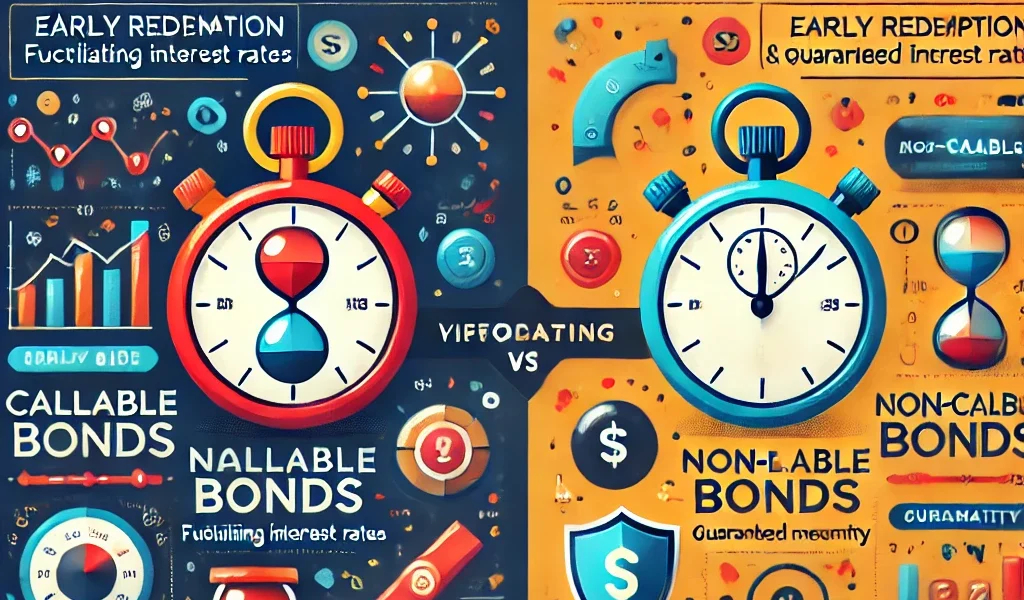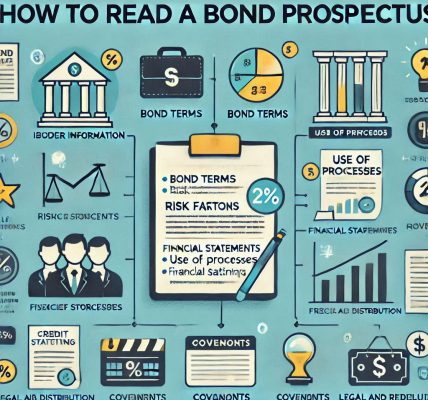When it comes to investing in bonds, understanding the different types available can help you make informed decisions and safeguard your portfolio against unforeseen risks. Two common types of bonds that investors encounter are callable bonds and non-callable bonds. Each has its own advantages and potential downsides, which can impact your returns and overall financial strategy.
In this blog, we will explore the key differences between callable and non-callable bonds, analyze the pros and cons of each, and determine which option is safer for your portfolio.
📚 Understanding Callable and Non-Callable Bonds
✅ What Are Callable Bonds?
Callable bonds, also known as redeemable bonds, give the issuer the right to repay the bond before its maturity date. Issuers usually exercise this option when interest rates decline, allowing them to refinance the debt at a lower interest rate.
- How They Work:
- An issuer issues a bond with a specified maturity date (e.g., 10 years).
- The bond pays periodic interest (coupon payments) to the bondholder.
- However, if interest rates drop, the issuer may “call” the bond and repay the principal earlier than the stated maturity date, saving on future interest payments.
- Example:
Suppose a company issues a 10-year callable bond with a 5% interest rate. If interest rates fall to 3% after 5 years, the company may decide to call back the bond and issue new bonds at the lower rate, reducing its cost of capital.
🚫 What Are Non-Callable Bonds?
Non-callable bonds, also known as bullet bonds, do not allow the issuer to repay the principal before the maturity date. The bondholder continues to receive interest payments until the bond matures, regardless of changes in interest rates.
- How They Work:
- The bond issuer commits to paying the coupon and returning the principal at maturity.
- Since the bond cannot be redeemed early, investors are protected from the risk of reinvestment at lower interest rates.
- Example:
A 10-year non-callable bond with a 5% interest rate will continue paying that rate for the full 10 years, even if interest rates decline during that period.
📊 Key Differences Between Callable and Non-Callable Bonds
| Feature | Callable Bonds | Non-Callable Bonds |
|---|---|---|
| Issuer’s Control | Can redeem early | Cannot redeem early |
| Interest Rate Risk | High for investors | Low for investors |
| Potential Returns | Higher yields to offset call risk | Lower yields due to stability |
| Reinvestment Risk | Higher risk | Lower risk |
| Price Stability | Less stable, fluctuates due to call risk | More stable, predictable |
🎯 Pros and Cons of Callable and Non-Callable Bonds
📈 Advantages of Callable Bonds
- Higher Yields:
To compensate for the call risk, callable bonds typically offer higher yields than non-callable bonds. - Potential for Early Return:
If you prefer to reinvest your money earlier than expected, a callable bond could provide that opportunity. - Flexibility for Issuers:
Issuers can take advantage of lower interest rates, reducing their overall cost of borrowing.
📉 Disadvantages of Callable Bonds
- Reinvestment Risk:
When a bond is called, investors may be forced to reinvest at lower interest rates, reducing their overall returns. - Uncertainty of Returns:
Since callable bonds can be redeemed before maturity, they introduce uncertainty in the income stream. - Price Volatility:
Callable bonds tend to have higher price volatility because of the uncertainty surrounding their maturity.
📈 Advantages of Non-Callable Bonds
- Predictable Income:
Investors can enjoy a predictable stream of income since the bond cannot be redeemed before maturity. - No Reinvestment Risk:
Non-callable bonds eliminate the risk of having to reinvest at lower interest rates if the bond is called. - Stable Price Behavior:
These bonds tend to exhibit lower price volatility, making them ideal for conservative investors.
📉 Disadvantages of Non-Callable Bonds
- Lower Yields:
Non-callable bonds typically offer lower yields compared to callable bonds due to the reduced risk for investors. - Lack of Flexibility for Issuers:
Issuers cannot take advantage of falling interest rates to refinance their debt, potentially leading to higher borrowing costs over time.
⚖️ Risk Analysis: Which Option Is Safer?
💡 Reinvestment Risk Consideration
- Callable bonds introduce a high degree of reinvestment risk. If the bond is called during a period of falling interest rates, investors are left with fewer options to reinvest their capital at comparable yields.
- Non-callable bonds, on the other hand, eliminate reinvestment risk, ensuring that investors continue to receive the agreed-upon interest rate until maturity.
📊 Stability of Income
- Non-callable bonds offer a safer, more predictable income stream, making them an attractive option for risk-averse investors.
- Callable bonds, while offering higher yields, introduce uncertainty in the timeline and stability of income.
💰 Long-Term Portfolio Protection
- For long-term stability and protection against interest rate fluctuations, non-callable bonds are a safer choice.
- However, investors willing to take on moderate risk for the potential of higher returns may prefer callable bonds.
📝 When Should You Choose Callable Bonds?
- If you are willing to accept the reinvestment risk in exchange for higher yields.
- If you believe interest rates are likely to remain stable or increase, reducing the likelihood of a call.
📝 When Should You Choose Non-Callable Bonds?
- If you prefer a predictable and stable income stream with minimal risk.
- If you want to avoid reinvestment risk and are focused on long-term portfolio security.
💡 Strategies to Mitigate Risk
- Diversification:
Combine callable and non-callable bonds to balance risk and returns. - Laddered Bond Portfolio:
Build a laddered portfolio with bonds of varying maturities to mitigate interest rate and reinvestment risks. - Monitor Interest Rate Trends:
Stay informed about interest rate movements to anticipate potential bond calls and plan accordingly.
🎨 Final Verdict: Which Option Is Safer for Your Portfolio?
For conservative investors seeking stable and predictable returns, non-callable bonds provide a safer option due to their immunity from early redemption and reinvestment risk. However, for investors willing to accept higher risk for the potential of greater returns, callable bonds may be a viable choice. A well-diversified portfolio that incorporates both types of bonds can strike a balance between safety and return.




